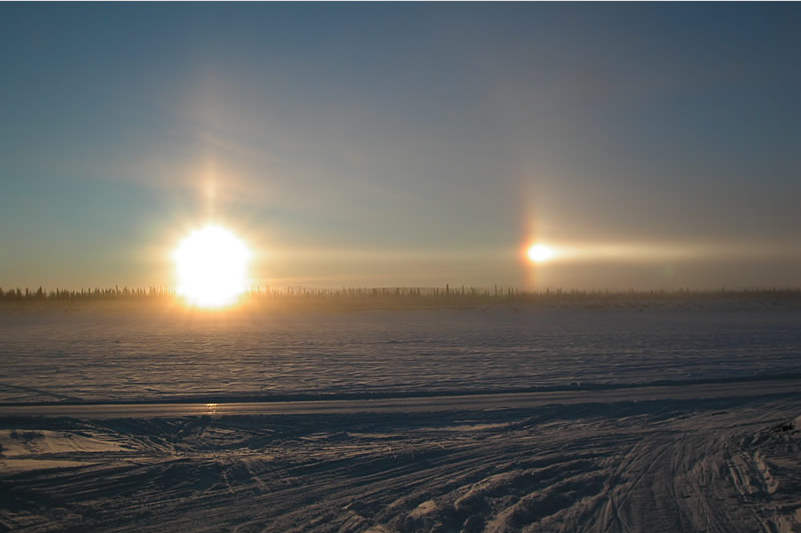Sun dog at Old Crow, Yukon, Canada
Sun Dog at Old Crow, Yukon, Canada: A Spectacular Atmospheric Phenomenon
The town of Old Crow, located north of the Arctic Circle in Yukon, Canada, is not only home to the Vuntut Gwitchin people but also to some breathtaking natural wonders. One such phenomenon is the occurrence of a vivid sundog, which was captured in a mesmerizing image by photographer Kai Rannik on January 29th, 2003. The photograph showcases the sundog against a backdrop of extreme cold, with temperatures plunging to a bone-chilling minus 42°C. Let's delve deeper into this captivating atmospheric optics event and explore the science behind it.
Unveiling the Sundog's Formation
The striking sundog featured in the image is created by diamond dust plate crystals suspended in the air. These tiny ice crystals, shaped like flat hexagonal plates, act as prisms, refracting and bending sunlight. As a result, a bright spot appears on either side of the sun, forming a halo-like effect. The sundog is characterized by its vibrant colors, often displaying shades of red, orange, and yellow, contrasting against the backdrop of the icy landscape.
Unraveling the Halo Mystery
Above the sundog in Rannik's photograph, we can observe a fragment of a 22° halo. Halos are optical phenomena that occur when light interacts with ice crystals in the atmosphere. In this case, the 22° halo is formed when sunlight passes through hexagonal ice crystals and is refracted at an angle of approximately 22 degrees. This creates a circular ring of light around the sun or moon, adding an ethereal touch to the already captivating scene.
The Parhelic Circle: A Radiant Halo Extension
Stretching horizontally from the sun in Rannik's photograph, we witness the parhelic circle, another intriguing element of atmospheric optics. The parhelic circle is a whitish band that appears to encircle the entire sky at the same altitude as the sun. It is caused by sunlight reflecting off horizontally oriented ice crystals, resulting in a luminous band that enhances the overall radiance of the scene. In this image, the parhelic circle noticeably brightens beyond the sundog, adding to the magical ambiance.
The Enigmatic Thin Pillar
A thin pillar can be seen extending vertically from the sun in Rannik's photograph. This pillar is a vertical column of light that appears to rise directly above or below the sun. It is created by the reflection and refraction of sunlight off ice crystals, similar to other atmospheric optical phenomena. The pillar adds an extra touch of intrigue to the composition, accentuating the surreal beauty of the Arctic landscape.
A Glimpse into Old Crow's Frozen Wonderland
Beyond the captivating atmospheric optics displayed in Rannik's photograph, it is worth mentioning the unique setting in which this natural spectacle took place. Old Crow, with its location north of the Arctic Circle, experiences extreme cold temperatures. The bone-chilling minus 42°C endured during the capture of this image serves as a reminder of the harsh yet awe-inspiring conditions that shape the Arctic environment.
A Visual Feast for the Senses
The combination of the sundog, the fragment of a 22° halo, the parhelic circle, and the thin pillar creates a truly remarkable visual feast for those fortunate enough to witness such atmospheric phenomena. The vibrant colors, radiant halos, and ethereal bands intertwine to form a scene that sparks wonder and amazement. Rannik's photograph provides us with a glimpse into the captivating world of atmospheric optics and reminds us of the beauty that can be found in even the most extreme environments.
In conclusion, the sundog captured at Old Crow, Yukon, Canada is a testament to the mesmerizing interplay between light and ice crystals in the atmosphere. It showcases the unique beauty of the Arctic landscape and offers a glimpse into the captivating world of atmospheric optics. The photograph serves as a reminder of the intricate wonders that nature has to offer, even in the harshest of conditions.

Sundog at Old Crow, Yukon, Canada imaged by Kai Rannik.
Old Crow (Home of the Vuntut Gwitchin) is north of the Arctic Circle on the confluence of the Crow and Porcupine Rivers. When this image was taken near noon on January 29th, 2003 the sun was not quite 3° high and the temperature was a numbing minus 42°C.
The bright sundog is formed by diamond dust plate crystals. Above it curves a fragment of a 22° halo. Stretching horizontally from the sun the parhelic circle characteristically brightens beyond the sun dog. A thin pillar reaches upward from the sun.
©2003 Vuntut Gwitchin First Nation, shown with permission.
Note: this article has been automatically converted from the old site and may not appear as intended. You can find the original article here.
Reference Atmospheric Optics
If you use any of the definitions, information, or data presented on Atmospheric Optics, please copy the link or reference below to properly credit us as the reference source. Thank you!
-
<a href="https://atoptics.co.uk/blog/sun-dog-at-old-crow-yukon-canada/">Sun dog at Old Crow, Yukon, Canada</a>
-
"Sun dog at Old Crow, Yukon, Canada". Atmospheric Optics. Accessed on April 20, 2024. https://atoptics.co.uk/blog/sun-dog-at-old-crow-yukon-canada/.
-
"Sun dog at Old Crow, Yukon, Canada". Atmospheric Optics, https://atoptics.co.uk/blog/sun-dog-at-old-crow-yukon-canada/. Accessed 20 April, 2024
-
Sun dog at Old Crow, Yukon, Canada. Atmospheric Optics. Retrieved from https://atoptics.co.uk/blog/sun-dog-at-old-crow-yukon-canada/.